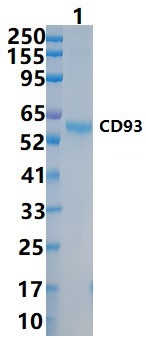Product Name :
CD93 Recombinant Protein Swiss-Prot :
Q9NPY3 Host :
E.coli Tag :
≥0.5mg/ml Amino acid Sequence :
ADTEAVVCVGTACYTAHSGKLSAAEAQNHCNQNGGNLATVKSKEEAQHVQRVLAQLLRRE AALTARMSKFWIGLQREKGKCLDPSLPLKGFSWVGGGEDTPYSNWHKELRNSCISKRCVS LLLDLSQPLLPSRLPKWSEGPCGSPGSPGSNIEGFVCKFSFKGMCRPLALGGPGQVTYTT PFQTTSSSLEAVPFASAANVACGEGDKDETQSHYFLCKEKAPDVFDWGSSGPLCVSPKYG CNFNNGGCHQDCFEGGDGSFLCGCRPGFRLLDDLVTCASRNPCSSSPCRGGATCVLGPHG KNYTCRCPQGYQLDSSQLDCVDVDECQDSPCAQECVNTPGGFRCECWVGYEPGGPGEGAC QDVDECALGRSPCAQGCTNTDGSFHCSCEEGYVLAGEDGTQCQDVDECVGPGGPLCDSLC FNTQGSFHCGCLPGWVLAPNGVSCTMGPVSLGPPSGPPDEEDKGEKEGSTVPRAATASPT RGPEGTPKATPTTSRPSLSSDAPITSAPLKMLAPSGSPGVWREPSIHHATAASGPQEPAG GDSSVATQNNDGTDGQK Restriction sites :
NdeI-XhoI Background :
The CD93 antigen is a 652 amino acid cell-surface glycoprotein expressed by monocytes, neutrophils, platelets, microglia, and endothelial cells. CD93 was originally thought to be a putative receptor for the complement component C1q, a serum glycoprotein which plays an integral role in the activation of the classical pathway in response to immune complexes. As a result, in the literature the CD93 gene product has also been referred to as C1QR1 and C1qRp as well as MXRA4 (matrix-remodeling-associated protein 4). Recent studies suggest that the CD93 antigen plays a role in intercellular adhesion and in clearance of apoptotic cells. CD93 is a heavily O-glycosylated, type I transmembrane protein consisting of an N-terminal domain with homology to C-type Lectin domains, a tandem array of EGF-like domains, a single transmembrane domain and a short cytoplasmic tail. Soluble :
PBS, 4M Urea, PH7.4 Purification&Purity :
Transferred into competent cells and the supernatant was purified by NI column affinity chromatography and the purity is > 85% (by SDS-PAGE). Storage&Stability :
Store at 4°C short term. Aliquot and store at -20°C long term. Avoid freeze-thaw cycles. Expression vector :
pet-22b(+) BiowMW :
~62kDa Note :
For research use only, not for use in diagnostic procedure. concentration :
≥0.5mg/ml
CD93 Recombinant Protein Swiss-Prot :
Q9NPY3 Host :
E.coli Tag :
≥0.5mg/ml Amino acid Sequence :
ADTEAVVCVGTACYTAHSGKLSAAEAQNHCNQNGGNLATVKSKEEAQHVQRVLAQLLRRE AALTARMSKFWIGLQREKGKCLDPSLPLKGFSWVGGGEDTPYSNWHKELRNSCISKRCVS LLLDLSQPLLPSRLPKWSEGPCGSPGSPGSNIEGFVCKFSFKGMCRPLALGGPGQVTYTT PFQTTSSSLEAVPFASAANVACGEGDKDETQSHYFLCKEKAPDVFDWGSSGPLCVSPKYG CNFNNGGCHQDCFEGGDGSFLCGCRPGFRLLDDLVTCASRNPCSSSPCRGGATCVLGPHG KNYTCRCPQGYQLDSSQLDCVDVDECQDSPCAQECVNTPGGFRCECWVGYEPGGPGEGAC QDVDECALGRSPCAQGCTNTDGSFHCSCEEGYVLAGEDGTQCQDVDECVGPGGPLCDSLC FNTQGSFHCGCLPGWVLAPNGVSCTMGPVSLGPPSGPPDEEDKGEKEGSTVPRAATASPT RGPEGTPKATPTTSRPSLSSDAPITSAPLKMLAPSGSPGVWREPSIHHATAASGPQEPAG GDSSVATQNNDGTDGQK Restriction sites :
NdeI-XhoI Background :
The CD93 antigen is a 652 amino acid cell-surface glycoprotein expressed by monocytes, neutrophils, platelets, microglia, and endothelial cells. CD93 was originally thought to be a putative receptor for the complement component C1q, a serum glycoprotein which plays an integral role in the activation of the classical pathway in response to immune complexes. As a result, in the literature the CD93 gene product has also been referred to as C1QR1 and C1qRp as well as MXRA4 (matrix-remodeling-associated protein 4). Recent studies suggest that the CD93 antigen plays a role in intercellular adhesion and in clearance of apoptotic cells. CD93 is a heavily O-glycosylated, type I transmembrane protein consisting of an N-terminal domain with homology to C-type Lectin domains, a tandem array of EGF-like domains, a single transmembrane domain and a short cytoplasmic tail. Soluble :
PBS, 4M Urea, PH7.4 Purification&Purity :
Transferred into competent cells and the supernatant was purified by NI column affinity chromatography and the purity is > 85% (by SDS-PAGE). Storage&Stability :
Store at 4°C short term. Aliquot and store at -20°C long term. Avoid freeze-thaw cycles. Expression vector :
pet-22b(+) BiowMW :
~62kDa Note :
For research use only, not for use in diagnostic procedure. concentration :
≥0.5mg/ml
Blocking peptide available as NCP0324P

 CD93 Recombinant Protein
CD93 Recombinant Protein 
 Datasheet
Datasheet COA
COA MSDS
MSDS SHIP
SHIP